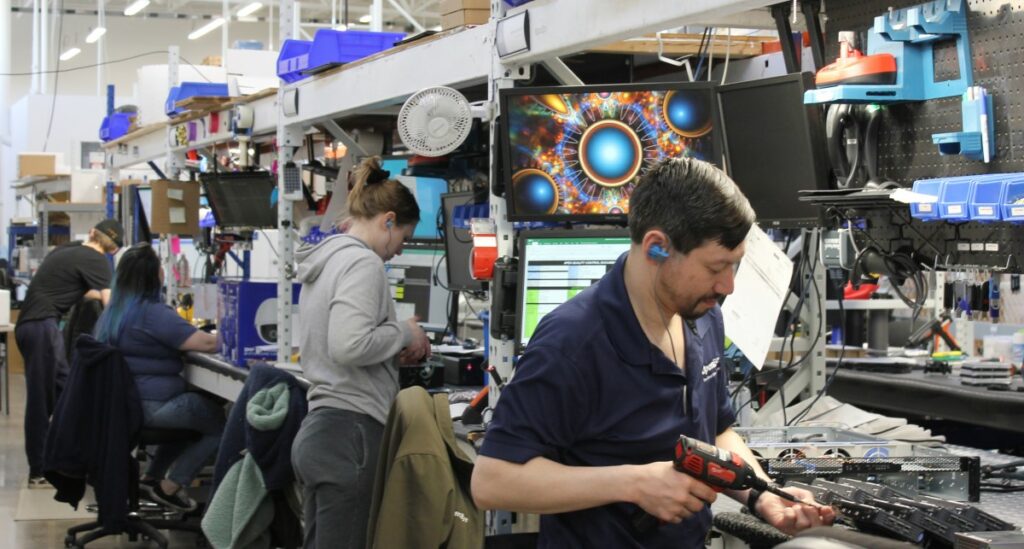Inside Alarm.com: Execs Detail Integration of Acquisitions, Areas of Focus & More
Alarm.com leadership discusses the company’s roadmap, including playing commercial catchup to its residential sector dominance.

Like a flashflood no one sees coming, Alarm.com rushed in to cleanse preconceived notions of what a residential security system could be and left the marketplace awash in a new wave of exciting and opportunistic innovation.
The upstart technology solutions provider’s paradigm-shifting platform made security systems more convenient with web and app interfaces, more useful with proactive nonalarm-event monitoring, and more secure and reliable with enhanced cellular communications.
In recent years, the firm has expanded its dealer-partnered offerings into the commercial business sector and made some significant acquisitions.

“For more than 20 years, Alarm.com has been pioneering smarter solutions that deliver total protection for millions of homes and businesses with one innovative and unified experience for a true smart property,” says President/CEO Steve Trundle, whose initial inspiration came from having a home alarm system installed and realizing the opportunity existed to build a better mousetrap.
“We operate the company with a ‘see a problem, solve a problem’ mentality. Whether that’s a problem that challenges our service provider or consumers are experiencing we strive to create truly useful offerings that solve real problems.”
Under Trundle’s watch — who earlier this year was elected into the SSI Industry Hall of Fame — Alarm.com grew from a gee-whiz startup with a few employees and no revenue to a public company valued at more than $3 billion.
Key to enabling that success has been a tight alliance with thousands of professional North American dealers who deploy the firm’s security as a service (SaaS) and automation recurring revenue offerings. Today, the company’s platform is connected to more than 100 million devices (for more, see Fast Facts box).
While Alarm.com for Business comprises only about 5% (400,000) of its overall 8.4 million subscriber base today, the company has been making a concerted effort to grow that segment through a combination of optimizing existing solutions and building out its portfolio with strategic acquisitions.
To unravel more details around that and the latest with the organization overall, SSI spoke with Alarm.com Chief Strategy and Innovation Officer Jeff Bedell, General Manager Commercial Sales Brian Lohse, OpenEye (acquired in 2019) CEO Rick Sheppard and Shooter Detection Systems (acquired in 2020) Managing Director Rich Onofrio.
Please describe how Alarm.com is structured today and how recent acquisitions fit in.
Jeff Bedell: Alarm.com’s core business is North American residential intrusion and smart home. It started with just alarm events but it’s expanded on the residential side to lights, locks, thermostats, video, video doorbell, garage door control, full smart home capabilities. That platform and services are what most people think of relative to Alarm.com and what a lot of our partners associate with the company.
Most of the marketing efforts and messaging go through using the Alarm.com brand. We would say you have Alarm.com for your home and everybody would understand that.
We have an Alarm.com for Business unit with its own sales team, product management team and marketing folks. It’s really now part of the core business because it was grown organically from within, and we continue to invest. It’s a transition of refining our core platform to work for a small- to medium-size business.
Our strategy in commercial has got a few different prongs to it. We’ve taken the Alarm.com residential interactive services platform and we’ve been investing in organic growth to enable that SMB to benefit from all the great integrated services that we provide in terms of intrusion, access control, and video, as well as some of the automation offerings like temperature monitoring.
Those are all stitched together in a single, simple, unified platform and really gets you a lot of the benefits you would expect in an integrated residential system. Of course, the SMB operator has a bunch of different technology and operational needs than a homeowner does. We refactor the platform and make a variant or a set of services that are specifically geared toward SMB.
When we acquired OpenEye, which we run as an independent business, what we saw was a higher tier of services that were required, specifically in the video surveillance domain, that Alarm.com for Business wasn’t offering at the time. We offer video capabilities, but they’re really suited at a lower configuration in terms of complexity, number of cameras and more advanced administrative features. OpenEye brings us upstream and they still sell to a different set of integrators.
There’s some overlap, but they’re a little bit higher up the commercial food chain than Alarm.com for Business, although the lines blur from time to time. Then when we acquired Shooter Detection Systems, they had been selling primarily to enterprises, the highest end of the commercial market.
We’re investing across the board. There’s a commonality in the sense that we can call it all commercial, but the end customers and the end partners, because in all cases we’re going through the partner channel not direct to the end consumer, but in concert with partners. The partner mix is all slightly different as well. We’re stratified across the entire pyramid of commercial opportunity at this point.

Alarm.com combines innovative software and hardware development with the sales/marketing expertise and local market knowledge of its service provider partners to drive adoption of connected property solutions.
How are the OpenEye and SDS transitions progressing? How close are they to being fully integrated into the Alarm.com platform?
Bedell: All of the platforms, in this case OpenEye and SDS, still have their own standalone, independent versions. They are operating their own software stack, but we have made sure that stack is operating with the robustness we would expect the Alarm.com Cloud to run. It’s integrated from a network operations standpoint. The other question is how does it appear to the end consumer of the technology? Does it look independent or is it totally unified? In the case of SDS, there is work we’re doing to integrate it directly into the Alarm.com for Business platform, but that’s a longer-term initiative.
We’re first and foremost making sure we’re making R&D investments in the SDS platform itself. Gunshot detection is a more nascent technology in general, it’s not as mature as say, video surveillance, VSaaS. There’s still work to be done to make sure we’re integrating in the right fashion and that the end solution makes sense.
In terms of the video solution, it’s important to understand when we acquired OpenEye we envisioned running two platforms. We wanted the optionality because their platform has integrations with other solution providers that would be deemed competitive with the Alarm.com for Business offering. Whether that be integration of the various access control platforms or other intrusion platforms, we want to give our partners a choice.
We don’t want to strongarm them into technology that you have to use this configuration. With that said, we put together a set of integration points where the Alarm.com for Business technology surfaces events and the OpenEye technology puts it on a video timeline, which is the way OpenEye integrates with a lot of its other partners.
Then with Alarm.com for Business, we’ve taken OpenEye’s technology assets and embedded them directly in the solution. It’s really under the covers and the end user will see the benefits in these enhanced VSaaS solutions if they’re using the Alarm.com for Commercial video offering, but they’re independent from the OpenEye platform. It’s a little complicated as you can tell.
Brian Lohse: If you want to use Alarm.com intrusion and access control and OpenEye video, the three play very nicely together. You can open the Alarm.com app, find this person, enter this door. I want to see the video, you click that event, it pulls up in the OpenEye app, jumps to the associated camera at the associated time of that event. There’s a fairly seamless integration between the two. There are tradeoffs to offering a more complex offering.
A lot of customers that choose Alarm.com for Business are looking for something that’s zero hassle in terms of need to have IT expertise or willingness to take a training class. If you look at SMB, a lot of it actually is consumer level in the sense of the time investment the owner is willing to spend. For that offering, you actually have to take options away to make it very easy to consume. Then you jump over the fence to OpenEye where you get much more sophisticated tools that higher end customer is looking for. There’s multiple ways to skin a cat depending on the specific needs of the customer.

The acquisition of OpenEye allows Alarm.com to offer Cloud-managed video surveillance solutions to integrators serving enterprise customers. In addition to acquisitions, Alarm.com has spent $300M on R&D the past couple years.
News recently broke that Alarm.com is getting into the solar business. Why the interest and where do you see that market heading?
Bedell: We’ve had elements in the platform that are specifically related to solar for some time. When we work with our partners, we’re constantly having discussions around where they’re trying to take their businesses. Several of our largest security partners have been getting into solar for a while. There’s been a bit of an acceleration that we’ve seen in the past 12 months. We decided to package up these assets we’ve developed and are largely sitting in a limited release or beta form.
It’s a mix of automation services, energy metering, integration with the solar inverter, all of this technology we’d had in a development state, we decided to release it in an actual product state. We did so in concert with interest from select partners believing there is a macro trend here where there’s going to be more residential solar. And there’s an obvious tie-in to the smart home around energy monitoring and metering that makes sense.
We’re big believers in these kinds of macro trends in the smart home. The real question is when is the market going to turn and partners really start to adopt and sell the integrated offering, sell security or home automation side by side with solar installations? We just reached critical mass where we’ve had enough interest from our security partners that it made sense for us to go ahead and launch the product formally.
How has this year’s supply chain and inflation challenges impacted Alarm.com?
Bedell: None of the inflation issues rippled through our Q1 numbers nor did the supply chain other than the costs. We haven’t suffered any product shortages, but like most vendors we have struggled somewhat with the cost to procure and ship the materials, so hardware margins have gone down. It’s been a different environment, but not a debilitating one at this point.
Fortunately, it hasn’t had a substantive impact on the growth of our business. In terms of the inflation, it’s still a bit too early to tell. Everybody’s worried about it, but it’s not had a direct impact where we can say we’ve seen things slow down. Everything I’ve seen so far is worriedness rather than actual impact.
Rick Sheppard: For OpenEye, the supply chain was definitely a significant challenge that needed to be managed through. For us, that culminated with average product lead times hitting an all-time high in the fourth quarter of 2021 with a peak of around 30 days. Anticipating this challenge, we worked with our finance partners at corporate to go all in on inventory so we could continue to heroically serve our partner base. Even with that enormous inventory investment, it took over 18 months to fully catch up.
I’m very pleased with the progress we’ve made. Our average lead time is back down to sub one week. I’m also really pleased with our new quick ship program where our channel partners have access to preconfigured inventory that’s ready to ship on a same- or next-day basis. This is quite exciting to a number of partners who have really struggled with fulfillment issues that have delayed and delayed projects they need to deploy.
Now we’re blowing the doors off with record sales. It is so important to now have the financial resources of an Alarm.com. Prior to the acquisition, we would not have been able to make such a big long-term, call it 18- to 24-month, commitment, forecasting giant rates of growth on inventory. In today’s supply chain environment, being able to make those commitments one, two years out is essential to being first in line when those chips become available.
Have you observed these factors affecting the businesses of your dealer customer base?
Sheppard: As it relates to cost, of course. No one expects the cost of technology, especially hardware, to increase with time. We’ve all become accustomed to things continually getting better at the same or a lower price point. Early this year we had to pass along a cost adjustment, which we delayed as long as possible.
We took a considerable margin hit and absorbed it internally for a long period of time hoping the supply chain would course correct on its own. Eventually it became clear some of this was going to be baked in on a permanent basis. From everything I’ve heard, our channel partners and users have been understanding of their need to pass those cost adjustments along.
Bedell: That’s similar to the business across the board. We have tried to delay passing along the cost increases we’re experiencing and it’s put real margin pressures on our hardware sales. Ultimately, we have had to make some price adjustments on particular products. No one is jumping up and down and super excited when we tell them we have to do it, but they’re seeing the reality of the market and they then have to come to terms on how they pass that along to their customers.
If you enjoyed this article and want to receive more valuable industry content like this, click here to sign up for our FREE digital newsletters!

Security Is Our Business, Too
For professionals who recommend, buy and install all types of electronic security equipment, a free subscription to Commercial Integrator + Security Sales & Integration is like having a consultant on call. You’ll find an ideal balance of technology and business coverage, with installation tips and techniques for products and updates on how to add to your bottom line.
A FREE subscription to the top resource for security and integration industry will prove to be invaluable.









great article. we have been looking at becoming an alarm.com dealer.